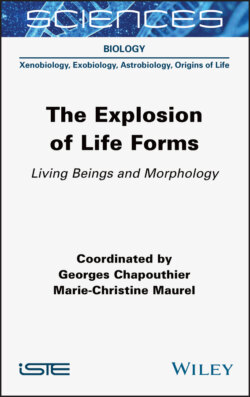Читать книгу The Explosion of Life Forms - Группа авторов - Страница 15
1.5. Compartmentalization of resources and primary biomass
ОглавлениеIn September 1969, a fireball exploded in the sky over Murchison, Australia, followed by a shower of meteorite fragments gathered in a few days. Extraterrestrial amino acids and hydrocarbons in the Murchison meteorite were quickly identified by David Deamer (1985), who showed that organic compounds in the meteorite could also assemble into membranes. Since then, many molecules of biological interest have been identified in other meteorites (Callahan et al. 2011).
Figure 1.4. Carbonaceous chondrite. Courtesy of Pierre Thomas (2016). For a color version of this figure, see www.iste.co.uk/chapouthier/life.zip
Deamer and Barchfeld (1982), Deamer and Pashley (1989), Deamer (1997), Dworkin et al. (2001), will be pioneers in the experimental study of organic compounds synthesized in space. Entering into the planetary atmosphere of the primitive Earth, they mixed with endogenous species, some of them amphiphilic, with polar and non-polar groups on the same molecule. They spontaneously self-assemble to form more complex bimolecular structures which, in turn, form membrane vesicles.
The self-assembly of amphiphilic compounds, lipids forming spherical vesicles, called “liposomes”, are capable of capturing macromolecules. The lipid bilayer is sufficiently permeable to allow exchanges with ionic and polar compounds from outside the compartment, allowing polymerization reactions, a kind of protometabolism, within these vesicles (Zepik et al. 2007). Hydrothermal sites are good candidates for the realization of such prebiotic evolution on the primitive Earth. Vesicles formed on mineral surfaces capture and produce diverse molecular systems. Each vesicle represents a protocell, a kind of chemical microreactor (Damer and Deamer 2015).
Laboratory simulations show that such vesicles easily encapsulate functional macromolecules, including nucleic acids and enzymes. RNA-type polymers are synthesized non-enzymatically in the laboratory from mononucleotides in lipid environments. RNA-type polymers identified by nanopore were analyzed by standard enzyme labeling methods, followed by gel electrophoresis. Chemical activation of the mononucleotides is not required. Instead, the synthesis of phosphodiester bonds is stimulated by the chemical potential of fluctuating anhydrous and hydrated conditions, with heat providing activation energy during the dehydration. In the final hydration step, the RNA-type polymer is encapsulated in lipid vesicles. This process provides the model for a possible first step in the evolution towards an RNA world (Rajamani et al. 2008).
Toppozini and her colleagues (2013) used X-ray diffraction to analyze mixtures of dehydrated self-assembled lipid multilamellar structures in the presence of a layer of mononucleotides such as adenosine monophosphate (AMP). The multilamellar structures are organizational structures, so condensation reactions of the mononucleotides into RNA-like polymers can thus occur (De Guzman et al. 2014; Misuraca et al. 2017).
Cell blanks were obtained by assembling phospholipids, amphiphilic molecules that interact through a hydrophilic head (which likes water) and a hydrophobic tail (which avoids any interaction with water). This structure allows organization in water in the form of vesicles. Researchers have shown that prebiotic compounds, such as polyprenyl phosphate, combine in water to form oriented double layers (Nakatani et al. 2014).
Jeff Errington (2013) followed the development of the Bacillus subtilis L-form (wall-free) bacterium and a liposome under the same conditions. Both bacteria and liposome split, fuse together and produce offspring in the form of small vesicles, which are morphologically very similar (see Figure 1.5). The unusual mode of proliferation of these bacteria by budding and fission could serve as a model for the in vitro simulation of vesicles or primitive cells. The binary fission mechanism provides insight into how early cell life forms were able to proliferate. Later in evolution, the invention of the protective cell wall may have been responsible for the expansion of bacterial life on Earth.
Figure 1.5. a) Proliferation of L-Bacillus subtilis. Courtesy of Jeff Errington. b) Liposome budding. Phospholipid vesicles in the presence of oleic acid. Courtesy of Primož Peterlin (2009)
Luisi and his collaborators were pioneers in the study of the processes by which lipid vesicles could develop and even reproduce (Walde et al. 1994a, 1994b; Luisi 2002, 2016). For example, it has been shown that when oleoyl anhydride was exposed to an aqueous buffer at alkaline pH, the anhydride was slowly hydrolyzed and the resulting oleic acid assembled into membrane vesicles. The vesicles can grow by the addition of fatty acids in the environment and then divide into smaller vesicles that grow, compete for resources, and even have a simple version of a feedback cycle that can regulate growth (Chen and Szostak 2004; Mansy and Szostak 2008; Adamala and Szostak 2013a, 2013b; Engelhart et al. 2016; Jimbo et al. 2016).
What can we deduce from these observations regarding our knowledge of the reproduction of the ancestors of today’s bacteria?
Briers et al. (2012) studied the gap between the first protocell and the hypothetical cell ancestor named “Luca”. Although there are striking coincidences between the two behaviors, the similarities observed still deserve long studies to confirm an ancestral morphological link and the understanding of the origins of unicellular life.
